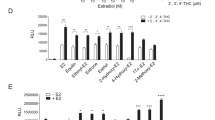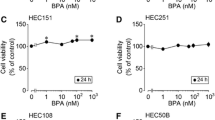Abstract
Selective estrogen receptor modulators (SERMs) have tissue-specific estrogen receptor (ER) modulating properties. Combining an SERM with one or more estrogens to form a tissue selective estrogen complex (TSEC) can provide an improved blend of tissue-specific ER agonist and antagonist effects. While both estrogens and SERMs affect the uterine endometrium, not all TSECs reverse the endometrial effects of estrogens preventing endometrial proliferation and hyperplasia. Their action in uterine cells is not completely understood. HOXA 10, leukemia inhibitory factor (LIF), progesterone receptor (PR), and EMX2 are genes known to regulate endometrial proliferation and differentiation. The expression of these genes was used to assess endometrial effects of SERMs and TSECs. We evaluated the effects of raloxifene (RAL), tamoxifen (TAM), lasofoxifene (LAS), bazedoxifene acetate (BZA), and progesterone (P) alone and in combination with estradiol (E2) in Ishikawa cells. Increased HOXA10, LIF, PR, and EMX2 messenger RNA (mRNA) expression was noted in E2-treated cells compared with vehicle-treated controls. All TSECs maintained E2-induced PR expression and all except TAM prevented estrogen-induced LIF expression. The TSEC containing BZA uniquely decreased HOXA10 expression and increased EMX2 expression. The TSECs alter endometrial cell proliferation by selective modulation of estrogen responsive genes, maintaining the antiproliferative effects mediated by PR and inhibiting LIF. The differential effect of TSECs on endometrial gene expression suggests a mechanism by which they manifest differential effects on endometrial safety against the risk of estrogen-induced endometrial hyperplasia.
Similar content being viewed by others
References
US Census Bureau. Table 1: annual estimates of the population by sex and five year age groups for the United States: April 1st, 2007. NC-EST20070-01. May 2008.
Gallagher JC, levine JP. Preventing osteoporosis in symptomatic postmenopausal women. Menopause. 2011;18(1):109–118.
Bachmann GA. Menopausal vasomotor symptoms: a review of causes, effects and evidence-based treatment options. J Reprod Med. 2005;50(3):155–165.
Panay N, Maamari R. Treatment of postmenopausal vaginal atrophy with 10-mug estradiol vaginal tablets. Menopause Int. 2012;18:15–19.
Taylor HS, Manson JE. Update in hormone therapy use in menopause. J Clin Endocrinol Metab. 2011;96(2):255–264.
Hardie C, Bain C, Walters M. Hormone replacement therapy: the risks and benefits of treatment. J R Coll Physicians Edinb. 2009;39(4):324–326.
Buick DL, Crook D, Horne R. Women’s perceptions of hormone replacement therapy: risks and benefits (1980–2002). A literature review. Climacteric. 2005;8(1):24–35.
Anderson GL, Limacher M, Assaf AR, et al. Effects of conjugated equine estrogen in postmenopausal women with hysterectomy: the Women’s Health Initiative randomized controlled trial. JAMA. 2004;291(14):1701–1712.
LaCroix AZ, Chlebowski RT, Manson JE, et al. Health outcomes after stopping conjugated equine estrogens among postmenopausal women with prior hysterectomy: a randomized controlled trial. JAMA. 2011;305(13):1305–1314.
Lethaby A, Farquar C, Sakris A, Roberts H, Jepson R, Barlow D. Hormone replacement therapy in postmenopausal women: endometrial hyperplasia and irregular bleeding. Cochrane Database Syst Rev. 2000;(2):CD000402.
Rossouw JE, Anderson GL, Prentice RL, et al. Risks and benefits of estrogen plus progestin in healthy postmenopausal women: principal results from the Women’s Health Initiative randomized controlled trial. JAMA. 2002;288(3):321–333.
Chlebowski RT, Anderson GL, Gass M, et al. Estrogen plus progestin and breast cancer incidence and mortality in postmenopausal women. JAMA. 2010;304(15):1684–1692.
Pickar JH, Mirkin S. Tissue-selective agents: selective estrogen receptor modulators and the tissue-selective estrogen complex. Menopause Int. 2010;16(3):121–128.
Cummings SR, Eckert S, Krueger KA, et al. The effect of raloxifene on risk of breast cancer in postmenopausal women: results from the MORE randomized trial. Multiple Outcomes of Raloxifene Evaluation. JAMA. 1999;281(23):2189–2197.
Barkhem T, Carlsson B, Nilsson Y, Enmark E, Gustafsson J, Nilsson S. Differential response of estrogen receptor alpha and estrogen receptor beta to partial estrogen agonists/antagonists. Mol Pharmacol. 1998;54(1):105–112.
Shang Y, Brown M. Molecular determinants for the tissue specificity of SERMs. Science. 2002;295(5564):2465–2468.
Klinge CM. Estrogen receptor interaction with co-activators and co-repressors. Steroids. 2000;65(5):227–251.
Miller CP. SERMs: evolutionary chemistry, revolutionary biology. Curr Pharm Des. 2002;8(23):2089–2111.
Chia S, Gradishar W. Fulvestrant: expanding the endocrine treatment options for patients with hormone receptor-positive advanced breast cancer. Breast. 2008;17(suppl 3):S16–S21.
Valachis A, Mauri D, Polyzos NP, Mavroudis D, Georgoulias V, Casazza G. Fulvestrant in the treatment of advanced breast cancer: a systematic review and meta-analysis of randomized controlled trials. Crit Rev Oncol Hematol. 2010;73(3):220–227.
Stovall DW, Tanner-Kurtz K, Pinkerton JV. Tissue-selective estrogen complex bazedoxifene and conjugated estrogens for the treatment of menopausal vasomotor symptoms. Drugs. 2011;71(13):1649–1657.
Gennari L, Merlotti D, De Paola V, Martini G, Nuti R. Bazedoxifene for the prevention of postmenopausal osteoporosis. Ther Clin Risk Manag. 2008;4(6):1229–1242.
Berrodin TJ, Chang KC, Komm BS, Freedman LP, Nagpal S. Differential biochemical and cellular actions of Premarin estrogens: distinct pharmacology of bazedoxifene-conjugated estrogens combination. Mol Endocrinol. 2009;23(1):74–85.
Lessey BA, Ilesanmi AO, Castelbaum AJ, et al. Characterization of the functional progesterone receptor in an endometrial adenocarcinoma cell line (Ishikawa): progesterone-induced expression of the alpha1 integrin. J Steroid Biochem Mol Biol. 1996;59(1):31–39.
Ishiwata I, Ishiwata C, Nagayama T, Ishikawa H. Histogenesis and culture of human uterine carcinosarcoma. Cancer Res. 1981;41(5):1978–1983.
Smith CC, Taylor HS. Xenoestrogen exposure imprints expression of genes (Hoxa10) required for normal uterine development. FASEB J. 2007;21(1):239–246.
Komm BS, Kharode YP, Bodine PV, Harris HA, Miller CP, Lyttle CR. Bazedoxifene acetate: a selective estrogen receptor modulator with improved selectivity. Endocrinology. 2005;146(9):3999–4008.
Daftary GS, Taylor HS. Endocrine regulation of HOX genes. Endocr Rev. 2006;27(4):331–355.
Vitiello D, Pinard R, Taylor HS. Gene expression profiling reveals putative HOXA10 downstream targets in the periimplantation mouse uterus. Reprod Sci. 2008;15(5):529–535.
Taylor HS, Arici A, Olive D, Igarashi P. HOXA10 is expressed in response to sex steroids at the time of implantation in the human endometrium. J Clin Invest. 1998;101(7):1379–1384.
Taylor HS, Daftary GS, Selam B. Endometrial HOXA10 expression after controlled ovarian hyperstimulation with recombinant follicle-stimulating hormone. Fertil Steril. 2003;80(suppl 2):839–843.
Daftary GS, Taylor HS. Implantation in the human: the role of HOX genes. Semin Reprod Med. 2000;18(3):311–320.
Das SK. Regional development of uterine decidualization: molecular signaling by Hoxa-10. Mol Reprod Dev. 2010;77(5):387–396.
Daftary GS, Taylor HS. Pleiotropic effects of Hoxa10 on the functional development of peri-implantation endometrium. Mol Reprod Dev. 2004;67(1):8–14.
Zanatta A, Rocha AM, Carvalho FM, et al. The role of the Hoxa10/HOXA10 gene in the etiology of endometriosis and its related infertility: a review. J Assist Reprod Genet. 2010;27(12):701–710.
Salamonsen LA, Nie G, Dimitriadis E, Robb L. Genes involved in implantation. Reprod Fertil Dev. 2001;13(1):41–49.
Senturk LM, Arici A. Leukemia inhibitory factor in human reproduction. Am J Reprod Immunol. 1998;39(2):144–151.
O’Malley BW. Steroid hormone receptors as transactivators of gene expression. Breast Cancer Res Treat. 1991;18(2):67–71.
Williams-Brown MY, Salih SM, Xu X, et al. The effect of tamoxifen and raloxifene on estrogen metabolism and endometrial cancer risk. J Steroid Biochem Mol Biol. 2011;126(3–5):78–86.
Kharode Y, Bodine PV, Miller CP, Lyttle CR, Komm BS. The pairing of a selective estrogen receptor modulator, bazedoxifene, with conjugated estrogens as a new paradigm for the treatment of menopausal symptoms and osteoporosis prevention. Endocrinology. 2008;149(12):6084–6091.
Archer DF, Lewis V, Carr BR, Olivier S, Pickar JH. Bazedoxifene/conjugated estrogens (BZA/CE): incidence of uterine bleeding in postmenopausal women. Fertil Steril. 2009;92(3):1039–1044.
Lass A, Weiser W, Munafo A, Loumaye E. Leukemia inhibitory factor in human reproduction. Fertil Steril. 2001;76(6):1091–1096.
Salamonsen LA, Menkhorst EED. Leukemia inhibitory factor and human endometrial receptivity. Indian J Physiol Pharmacol. 2010;54:17–26.
Kimber SJ. Leukaemia inhibitory factor in implantation and uterine biology. Reproduction. 2005;130(2):131–145.
Cullinan EB, Abbondanzo SJ, Anderson PS, Pollard JW, Lessey BA, Stewart CL. Leukemia inhibitory factor (LIF) and LIF receptor expression in human endometrium suggests a potential autocrine/paracrine function in regulating embryo implantation. Proc Natl Acad Sci U S A. 1996;93(7):3115–3200.
Sawai K, Matsuzaki N, Okada T, et al. Human decidual cell biosynthesis of leukemia inhibitory factor: regulation by decidual cytokines and steroid hormones. Biol Reprod. 1997;56(5):1274–1280.
Barakat RR. The effect of tamoxifen on the endometrium. Oncology (Williston Park). 1995;9(2):129–134.
Kedar RP, Bourne TH, Powles TJ, et al. Effects of tamoxifen on uterus and ovaries of postmenopausal women in a randomised breast cancer prevention trial. Lancet. 1994;343(8909):1318–1321.
Lahti E, Blanco G, Kauppila A, Apaja-Sarkkinen M, Taskinen PJ, Laatikainen T. Endometrial changes in postmenopausal breast cancer patients receiving tamoxifen. Obstet Gynecol. 1993;81(5pt 1):660–664.
Allan GF, Hutchins A, Liu X, Clancy J. Induction of the progesterone receptor gene in estrogen target cells monitored by branched DNA signal amplification. Steroids. 2001;66(9):663–671.
Bramlett KS, Burris TP. Target specificity of selective estrogen receptor modulators within human endometrial cancer cells. J Steroid Biochem Mol Biol. 2003;86(1):27–34.
Troy PJ, Daftary GS, Bagot CN, Taylor HS. Transcriptional repression of peri-implantation EMX2 expression in mammalian reproduction by HOXA10. Mol Cell Biol. 2003;23(1):1–13.
Noonan FC, Mutch DG, Ann Mallon M, Goodfellow PJ. Characterization of the homeodomain gene EMX2: sequence conservation, expression analysis, and a search for mutations in endometrial cancers. Genomics. 2001;76(1–3):37–44.
Taylor HS, Fei X. Emx2 regulates mammalian reproduction by altering endometrial cell proliferation. Mol Endocrinol. 2005;19(11):2839–2846.
Peiffer-Schneider S, Noonan FC, Mutch DG, et al. Mapping an endometrial cancer tumor suppressor gene at 10q25 and development of a bacterial clone contig for the consensus deletion interval. Genomics. 1998;52(1):9–16.
Duggan ST, McKeage K. Bazedoxifene: a review of its use in the treatment of postmenopausal osteoporosis. Drugs. 2011;71(16):2193–2212.
Silverman S, Christiansen C. Individualizing osteoporosis therapy. Osteoporos Int. 2012;23(3):797–809.
Taylor HS. Using bazedoxifene plus conjugated estrogens for treating postmenopuasal women: a comprehensive review. Menopause. 2012;19(4):479–485.
Archer DF, Pinkerton JV, Utian WH, et al. Bazedoxifene, a selective estrogen receptor modulator: effects on the endometrium, ovaries, and breast from a randomized controlled trial in osteoporotic postmenopausal women. Menopause. 2009;16(6):1109–1115.
Author information
Authors and Affiliations
Corresponding author
Rights and permissions
About this article
Cite this article
Kulak, J., Ferriani, R.A., Komm, B.S. et al. Tissue Selective Estrogen Complexes (TSECs) Differentially Modulate Markers of Proliferation and Differentiation in Endometrial Cells. Reprod. Sci. 20, 129–137 (2013). https://doi.org/10.1177/1933719112463251
Published:
Issue Date:
DOI: https://doi.org/10.1177/1933719112463251




